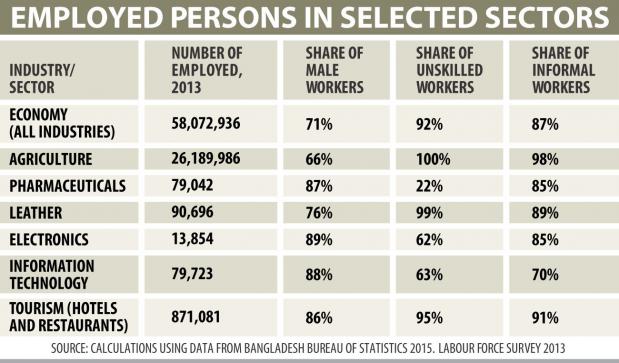 Bangladesh needs 8 percent economic growth annually to absorb the surplus labour in the economy in the next 15 years, said a new study by the Asian Development Bank yesterday. “While manufacturing will continue to be the engine of growth and a major source of productive employment, the manufacturing base will need to diversify, and the sector will have to grow about 12-15 percent over the next 15 years,” the study said. More labour-intensive sectors, including garment, will have to continue to grow. Agriculture should also diversify to create more productive employment. The policy regime has to be neutral for non-garment industries with the same growth potential, according to the study. The construction sector also has great potential for employment, although in recent years the sector has shown some degree of instability. The study also suggested improving labour productivity and increasing the real wages. “Quality of employment needs to improve in other respects like in terms of contract, social protection and workplace safety,” said the report: Bangladesh Employment Diagnostic Study — Looking Beyond Garments. Rizwanul Islam, lead research consultant of the study, presented the findings at a seminar at Hotel Radisson in Dhaka. The International Labour Organisation and ADB jointly conducted the study. Using data from the 2013 Labour Force Survey, the study found that unemployment rates for workers at all education levels except for those who never attended school have declined since 2010. The analysis shows the gap in earnings between education levels has been narrowing, with the exception of secondary education, where graduates continue to earn increasingly more than those with only primary education. In addition, greater access to education for women leads to their finding better jobs, while their rising employment in the garment sector has been associated with reductions in poverty, the study said. The participation of children in economic activities, especially the family-run ones such as agriculture and other informal sector activities, is age-old in developing countries like Bangladesh. However, a variety of factors, such as a decline in acute poverty, higher enrolment in primary education and a strong campaign against the practice, has led to a gradual decline in the phenomenon. While Bangladesh has successfully created manufacturing jobs, particularly in textiles and garments, it has been unable to create a large pool of jobs in industries outside the garment sector. Jobs in the service sector are, for the most part, informal, particularly in wholesale and retail trade. Nonetheless, some areas of manufacturing as well as some promising service sectors such as information technology, software, machinery repair and tourism have the potential to grow further if the right incentives are set, according to the study. Jobs in agriculture for the most part continue to be informal and not very productive, yet Bangladesh has the opportunity to invest more in agricultural value chains, which would help to bring farmers to market and raise their incomes. However, several supply-side factors have contributed to constraining economic diversification, some of which relate to employment, like shortage of skilled workers, technological bottlenecks, and lack of entrepreneurship and management skills. Although labour in Bangladesh is abundant, a shortage in skilled workers is perceived to be a major constraint on manufacturing production. The shortage is particularly acute for medium-scale, export-oriented enterprises. Manufacturing goods now overwhelmingly dominate Bangladesh’s export basket, but a significant proportion of it comprises a very low domestic value addition because of limited backward linkages. While Bangladesh has done well in maintaining a steady outflow of migrant workers, the study found there is potential to raise this number and change the skills and occupational composition of workers. For Bangladeshis to find more jobs abroad, it would be necessary to tap both existing destinations such as Bahrain, Oman Qatar and Singapore and new ones such as Jordan, Lebanon and the Republic of Korea. Different destinations and their prospects can be studied by employing various means such as analysis of the economies and their business prospects and intensifying bilateral contacts. The high cost of international migration from Bangladesh is a major issue. The cost not only includes the charges for air tickets, visas and so on, but also the fees paid to recruiting agencies and intermediaries. Apart from financial cost, common problems include fraudulent practices, substitution of contracts in destination countries for ones with much worse terms. “Although, Bangladesh has been obtaining around seven percent economic growth every year, unfortunately our labour market is not growing,” Islam said. While around five lakh find jobs abroad every year, efforts must be made on local job creation. “We are exporting unskilled labour mostly and importing midlevel skilled manpower from other countries — there should be a balance with the exchange.” Srinivas Reddy, country director of ILO, called for education for young men and women so that they can become more capable in management. He also urged the government to continue its support to the garment sector and look at the non-discrimination policy. “Social protection is a very important issue and Bangladesh should invest more on it,” Reddy added. Syed Nasim Manzur, president of Metropolitan Chamber of Commerce and Industry, said: “We have to spend a lot of money for importing goods due to delays in releasing them at the airport.” He called for withdrawal of duty on import of fire safety materials for sectors other than garment. “There should have a sustainable package for the non-garment sectors as well.” Source: The Daily Star
Bangladesh needs 8 percent economic growth annually to absorb the surplus labour in the economy in the next 15 years, said a new study by the Asian Development Bank yesterday. “While manufacturing will continue to be the engine of growth and a major source of productive employment, the manufacturing base will need to diversify, and the sector will have to grow about 12-15 percent over the next 15 years,” the study said. More labour-intensive sectors, including garment, will have to continue to grow. Agriculture should also diversify to create more productive employment. The policy regime has to be neutral for non-garment industries with the same growth potential, according to the study. The construction sector also has great potential for employment, although in recent years the sector has shown some degree of instability. The study also suggested improving labour productivity and increasing the real wages. “Quality of employment needs to improve in other respects like in terms of contract, social protection and workplace safety,” said the report: Bangladesh Employment Diagnostic Study — Looking Beyond Garments. Rizwanul Islam, lead research consultant of the study, presented the findings at a seminar at Hotel Radisson in Dhaka. The International Labour Organisation and ADB jointly conducted the study. Using data from the 2013 Labour Force Survey, the study found that unemployment rates for workers at all education levels except for those who never attended school have declined since 2010. The analysis shows the gap in earnings between education levels has been narrowing, with the exception of secondary education, where graduates continue to earn increasingly more than those with only primary education. In addition, greater access to education for women leads to their finding better jobs, while their rising employment in the garment sector has been associated with reductions in poverty, the study said. The participation of children in economic activities, especially the family-run ones such as agriculture and other informal sector activities, is age-old in developing countries like Bangladesh. However, a variety of factors, such as a decline in acute poverty, higher enrolment in primary education and a strong campaign against the practice, has led to a gradual decline in the phenomenon. While Bangladesh has successfully created manufacturing jobs, particularly in textiles and garments, it has been unable to create a large pool of jobs in industries outside the garment sector. Jobs in the service sector are, for the most part, informal, particularly in wholesale and retail trade. Nonetheless, some areas of manufacturing as well as some promising service sectors such as information technology, software, machinery repair and tourism have the potential to grow further if the right incentives are set, according to the study. Jobs in agriculture for the most part continue to be informal and not very productive, yet Bangladesh has the opportunity to invest more in agricultural value chains, which would help to bring farmers to market and raise their incomes. However, several supply-side factors have contributed to constraining economic diversification, some of which relate to employment, like shortage of skilled workers, technological bottlenecks, and lack of entrepreneurship and management skills. Although labour in Bangladesh is abundant, a shortage in skilled workers is perceived to be a major constraint on manufacturing production. The shortage is particularly acute for medium-scale, export-oriented enterprises. Manufacturing goods now overwhelmingly dominate Bangladesh’s export basket, but a significant proportion of it comprises a very low domestic value addition because of limited backward linkages. While Bangladesh has done well in maintaining a steady outflow of migrant workers, the study found there is potential to raise this number and change the skills and occupational composition of workers. For Bangladeshis to find more jobs abroad, it would be necessary to tap both existing destinations such as Bahrain, Oman Qatar and Singapore and new ones such as Jordan, Lebanon and the Republic of Korea. Different destinations and their prospects can be studied by employing various means such as analysis of the economies and their business prospects and intensifying bilateral contacts. The high cost of international migration from Bangladesh is a major issue. The cost not only includes the charges for air tickets, visas and so on, but also the fees paid to recruiting agencies and intermediaries. Apart from financial cost, common problems include fraudulent practices, substitution of contracts in destination countries for ones with much worse terms. “Although, Bangladesh has been obtaining around seven percent economic growth every year, unfortunately our labour market is not growing,” Islam said. While around five lakh find jobs abroad every year, efforts must be made on local job creation. “We are exporting unskilled labour mostly and importing midlevel skilled manpower from other countries — there should be a balance with the exchange.” Srinivas Reddy, country director of ILO, called for education for young men and women so that they can become more capable in management. He also urged the government to continue its support to the garment sector and look at the non-discrimination policy. “Social protection is a very important issue and Bangladesh should invest more on it,” Reddy added. Syed Nasim Manzur, president of Metropolitan Chamber of Commerce and Industry, said: “We have to spend a lot of money for importing goods due to delays in releasing them at the airport.” He called for withdrawal of duty on import of fire safety materials for sectors other than garment. “There should have a sustainable package for the non-garment sectors as well.” Source: The Daily Star









